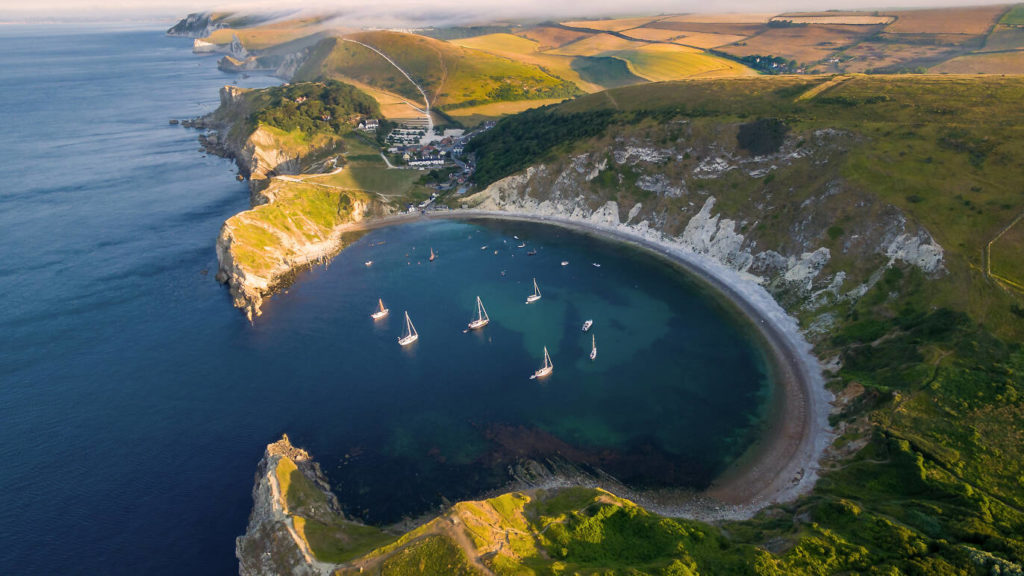Iconic landmarks, unique rock formations and stunning coastal scenery are some of the reasons Instagram has been flooded by breathtaking photos of Dorset.
There’s no shortage of scenic shots. Dorset is a county full of hotspots that attracts visitors from all over the U.K. These landmarks are all within a 1 hr 15 minute drive from our properties in Lyme Regis.
Durdle Door is one of Dorset’s most photogrpahed and iconic landmarks, being part of the Jurassic Coast UNESCO World Heritage site. It’s rock formation is a natural arch comprised of hard limestone that stands upright out of the sea.
The beach is approximately a 15 minute walk driectly from a car park that sits above the landmark. The walk is across a steep path and steps down onto the beach, so you’ll definitely need appropriate footwear for the trip! But the views and setting are incredible, and well worth it.
Be aware there are no toilets on the beach at Durdle Door. The nearest toilets are found at Durdle Door Holiday Park which is part of Lulworth Estate, owned and managed by the Weld Family – take a look at their website for more information and to plan your visit.
Durdle Door is a dog-friendly beach and can be enjoyed with your fury friend all year round.

Photo credit: Lulworth Estate

Photo credit: Martin G – mgphotography.uk
A stunning cove formed by natural forces of sea and river water as well as melting ice at the end of the Ice Age. Lulworth Cove is world famous for its unique geology and spectacular landforms including Lulworth Crumple and Stair Hole.
You can expect panoramic views and crystal clear waters on this stretch of the UNESCO World Heritage Site. This a must-visit destination of the Jurassic Coast, with activities from rock-pooling and watersports, to walking, coasteering or if you prefer the slower lifestyle, just relax with an ice cream surrounded by the fresh sea air.
Lulworth Cove will be a destrination you remember forever, it’s simply beautiful.

Photo credit: Time Out
At West Bay, you can find a striking set of crumbling golden cliffs, that reveal land formations from some 175 million years ago. Here the famous Chesil Beach is located, 18 miles long and born from landslides that eroded after the last Ice Age.
In summer you will hear the sound of laughter and the smell of BBQs. When winter storms blow in, these shores, the cliffs and beaches change with rock falls that remind us that this natural place hides dangers as well as pleasures. Nearby there are plenty of places to eat and enjoy with the West Bay Harbour close by.
The Jurassic Coaster bus service is another option to visit West Bay if you didn’t drive by car.
Photo credit: West Bay Photography

Photo credit: National Trust
The dramatic ruins of Corfe Castle stand on a natural hill guarding the principal route through the Purbeck Hills. It was initially built to guard the gap between the south of Purbeck, where Purbeck marble was once quarried, and the rest of England. Nothing could pass in or out without going past the Castle.
Corfe Castle certainly has had a colourful history. It was one of the first castles in England and would have been built of wood, dating back to 979 where King Edward was reputedly murdered by his step-mother so that her own son could become King of England. In the latter half of the 11th Century the Castle was rebuilt in stone by William the Conqueror and for the next six hundred years was a royal fortress used by the monarchs of England and latterly their constables.
The beautiful picturesque village of Beer is located on the Devon border and just a 15 minute drive from Lyme Regis. The shingle beach is surrounded by white chalk cliffs and lined with fishing boats still bringing in their daily catches, famous for its mackerel produce.
Beer is on the edge of the South West Coast Path and has some of the most stunning coastal walks in the county. The fishing village has also been named by Countryfile as the Top Picnic spot in the UK from Jubilee Gardens at the top of the headland, chosen for its stunning view of the beach and Jurassic Coastline.


Photo credit: Jurassic Coast Trust

Photo credit: National Trust
Standing tall at the southern end of Studland Bay, is one of the most famous landmarks on the South Coast – Old Harry Rocks.
The towering chalk formations at Handfast Point are stunning geological formations and ideal for the photographer within you!
Old Harry is the first major landmark for walkers tackling the South West Coast Path from East to West. Breathtaking views of the Jurassic coast and unique rock formations await you on this circular walk, put together by The National Trust.
Pulpit rock is a coastal landmark feature at Portland Bill, the southern tip of the Isle of Portland, Dorset and was formed in the 19th century.
Quarying began in the late 19th century at Portland Bill and remained a small operation until the early 20th century. One area abosrbed into the quarries was the natural stone formation called White Hole. Overtime, much of the White Hole was removed by quarymen leaving a stack of rock deyached from Portland Bill.
Access to the top was retained by a large slab of rock leaning right against it, which was named Pulpit Rock.

Photo credit: Visit Dorset